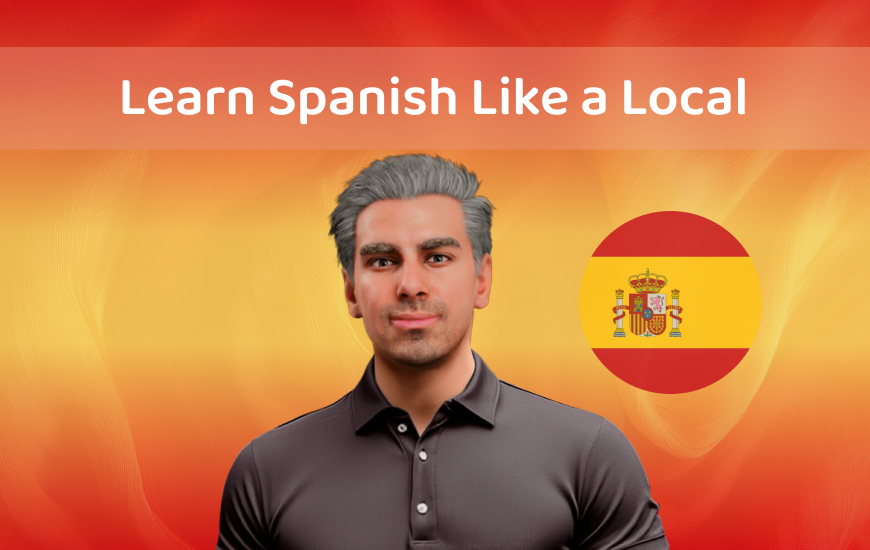¡Hola, amigos! Alejandro here—your personal Spanish tutor and biggest cheerleader. Learning Spanish is about stepping into real-life moments, like sipping a café con leche at a bustling café in Madrid or cheering “¡Golazo!” at a local soccer match. These small, everyday experiences are where the magic happens, and they’re exactly what will make you sound less like a tourist and more like a local. So, grab your favorite snack, settle in, and let’s dive into how practicing Spanish in real-life scenarios can take your fluency to the next level. Ready? ¡Vamos!
Go From Awkward to Awesome
Brains crave stories. Your mind is like a sponge when there’s a story behind the words. It helps you go beyond just memorizing random vocabulary; it creates meaningful connections.
- Picture this: You’re lost in a quaint Spanish village and ask, “¿Dónde está la plaza?” (Where is the plaza?). You don’t just learn the word plaza—you remember the cobblestone streets and the kind stranger who helped you.
- Practice with purpose: Try using phrases you’d need in your daily life like ordering churros or asking for directions, and watch how quickly new words stick.
Local Vibes, Unlocked
Want to sound like you belong? Situational practice lets you pick up slang and cultural nuances that textbooks skip.
- Skip the stiff phrases: Instead of “Buenos días, señor,” you might hear locals say, “¿Qué tal?” (What’s up?).
- Learn to blend in: Try “¡Qué chulo!” (How cool!) when admiring something awesome in Spain. You’ll sound like a natural.
Café Confidence: Mastering the Art of Ordering Coffee
Ordering coffee in Spanish is like unlocking the first level of fluency—it’s practical, fun, and oh-so-rewarding. Imagine walking into a cozy café in Madrid or a lively coffee shop in Bogotá and ordering like you’ve been doing it forever. Let’s make that happen.
Start Simple: Your Go-To Phrases
You don’t need to be fluent to order coffee confidently. Start with these:
- “Quiero un café con leche, por favor.” (I’d like a latte, please.)
- “¿Me puedes recomendar algo típico?” (Can you recommend something local?)
- “Para llevar, por favor.” (To-go, please.)
Keep it straightforward. Politeness is key, and a smile goes a long way.
Add Some Personality
Once you’re comfortable, spice it up with some extras:
- Ordering sizes: “Un café pequeño/mediano/grande, por favor.” (A small/medium/large coffee, please.)
- Customize like a local: “¿Me puedes añadir un poco de canela?” (Can you add a little cinnamon?)
- Pro tip: Learn regional terms. In Mexico, try “un café de olla” (traditional spiced coffee).
Learn to Handle the Unexpected
What if they ask you something you don’t understand? Don’t panic—here’s how to handle it:
- “¿Perdón, puedes repetir?” (Sorry, can you repeat that?)
- “¿Qué significa…?” (What does … mean?)
- Use context clues: If they point at the milk options, just say, “Leche entera, por favor” (Whole milk, please).
Make It a Conversation
Coffee shops are social hubs—why not practice small talk?
- Compliment the café: “¡Qué bonito lugar!” (What a lovely place!)
- Ask about the beans: “¿De dónde viene este café?” (Where is this coffee from?)
Lost but Fluent: Asking for Directions Like a Pro
Getting lost can feel stressful, but it’s also the perfect chance to practice your Spanish! Imagine wandering through winding streets in Seville or a bustling market in Mexico City. Here’s how to turn that moment of being lost into an opportunity to shine.
Start with the Basics
When you need to ask for directions, keep it simple and clear. These phrases will save the day:
- “¿Dónde está…?” (Where is…?)
- Example: “¿Dónde está la estación de tren?” (Where is the train station?)
- “¿Cómo llego a…?” (How do I get to…?)
- Example: “¿Cómo llego al museo?” (How do I get to the museum?)
- “¿Hay un… cerca de aquí?” (Is there a … near here?)
- Example: “¿Hay un supermercado cerca de aquí?” (Is there a supermarket nearby?)
Understand the Answers
Locals may answer quickly, but don’t worry—you can still follow along with these key directional phrases:
- “A la derecha” (To the right)
- “A la izquierda” (To the left)
- “Todo recto” (Straight ahead)
- “A dos cuadras” (Two blocks away)
If you’re unsure, politely ask:
- “¿Puedes repetirlo más despacio, por favor?” (Can you repeat it slower, please?)
Pro Tips for Success
Here’s how to make the most of the interaction:
- Use landmarks: Ask, “¿Está cerca de la plaza?” (Is it near the plaza?) for clarity.
- Bring a map: Pointing to your map while asking makes things easier.
- Say thank you: “¡Muchas gracias!” (Thank you very much!) shows appreciation.
Stay Calm and Confident
Even if you don’t catch every word, locals will appreciate your effort. A friendly attitude and a smile go a long way. In our sessions, I’ll prepare you in case you get lost in an exciting place like Lima. I’ll help you master not just the language but also the confidence to handle urgent situations like a pro.
Market Magic: Shopping Like a Local
Markets in Spanish-speaking countries are vibrant, colorful, and brimming with opportunities to practice your Spanish. Whether you’re hunting for fresh produce in Mexico City or handmade crafts in Bogotá, shopping at a local market is an immersive language experience. Let’s turn you into a market maestro!
Essential Phrases to Get Started
Before diving into negotiations, arm yourself with these must-know phrases:
- “¿Cuánto cuesta?” (How much does it cost?)
- Example: “¿Cuánto cuesta esta pulsera?” (How much does this bracelet cost?)
- “¿Tiene algo más barato?” (Do you have something cheaper?)
- Perfect for finding a bargain.
- “Me gusta, pero es un poco caro.” (I like it, but it’s a little expensive.)
- A polite way to hint at a discount.
Bargain Like a Local
Haggling isn’t just expected—it’s part of the fun! Here’s how to do it respectfully:
- Start with a smile: “¿Es su mejor precio?” (Is that your best price?)
- Offer a counter: If they say 100 pesos, try, “¿Y 80 pesos?” (How about 80 pesos?)
- Know when to stop: If the vendor won’t budge, thank them and move on.
Ask Questions to Show Interest
Vendors love when you’re curious about their goods. Ask about the products:
- “¿Está hecho a mano?” (Is it handmade?)
- “¿De dónde viene esto?” (Where is this from?)
- “¿Qué recomienda?” (What do you recommend?)
These questions not only help you practice but also build a connection with the vendor.
Pro Tips for Navigating the Market
- Bring cash: Many vendors don’t accept cards.
- Learn numbers: Being confident with prices helps avoid confusion.
- Observe locals: Watch how they shop and mimic their style.
Grab your reusable bag, brush up on your Spanish with me in the Praktika app, and start practicing shopping like a local.
The Soccer Sidelines: Making Friends Through Sports
Sports are a universal language, and fútbol (soccer) is the king of them all in Spanish-speaking countries. Whether you’re playing in a pickup game or cheering on a local team, the soccer sidelines are a fantastic place to connect with people, practice your Spanish, and make lifelong friends. Let’s kick off!
Breaking the Ice: Start with Simple Questions
The soccer field is the perfect place to strike up a conversation. Here are some go-to icebreakers:
- “¿Juegas seguido?” (Do you play often?)
- “¿De qué equipo eres?” (Which team do you support?)
- “¿Quieres jugar en mi equipo?” (Do you want to play on my team?)
These phrases not only help you practice Spanish but also show you’re genuinely interested in joining in.
Learn the Lingo: Soccer-Specific Vocabulary
Knowing the right terms will make you sound like a pro. Some must-know fútbol words include:
- Golazo: An amazing goal
- Pase: Pass
- Falta: Foul
- Portero/Arquero: Goalkeeper
Try shouting, “¡Buen pase!” (Nice pass!) or “¡Qué golazo!” (What a goal!) to blend in with the crowd.
Build Friendships Beyond the Game
The sidelines aren’t just for cheering—they’re for bonding. Here’s how to connect:
- Compliment their skills: “¡Eres buenísimo jugando!” (You’re great at playing!)
- Plan a rematch: “¿Jugamos otra vez mañana?” (Shall we play again tomorrow?)
- Ask for tips: “¿Cómo aprendiste a jugar así?” (How did you learn to play like that?)
Practice Cultural Respect
Soccer is serious business in many Spanish-speaking countries, so keep these tips in mind:
- Respect the rules, even in casual games.
- Applaud great plays from both sides—sportsmanship matters.
- If invited to celebrate after the game, join in! It’s a chance to practice social Spanish.
Your Next Steps: Embrace Every Opportunity to Speak
- Find Everyday Moments to Practice
- Opportunities to practice are everywhere—you just need to spot them! When in doubt, open up the Prakikta app and try out a new conversation with me.
- Talk to People, Not Just Apps
- Tech is great, but real-life conversations are the real MVP. Practice with me then step out into the world!
- Join a local language exchange
- Many communities have meetups where you can practice with native speakers.
- Order in Spanish at a restaurant
- It’s a low-pressure way to get comfortable.
- Ask a stranger for directions
- Start with “¿Me puede ayudar?” (Can you help me?) and see where it takes you.
Let’s Make It Happen Together
Think of learning Spanish like you’re building a bridge—you take it one step at a time until it spans the gap. With an AI English tutor like me by your side, you’ll have the confidence to speak, the tools to grow, and the energy to keep going. Ready to take the plunge and start speaking Spanish every day? Let’s practice together in the Praktika app! I’ll help you turn every opportunity into a win. ¡Vamos!

From Alejandro
Alejandro is a passionate Spanish and English tutor with an MA in Physical Activity and Education from the University of Barcelona. A former pro soccer player and current coach, he loves helping learners tackle new challenges—whether on the field or in language learning. With his multicultural background and encouraging style, Alejandro makes every lesson feel like a win.
